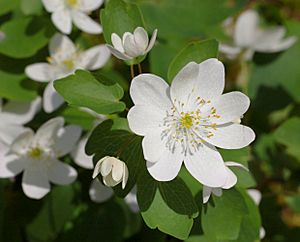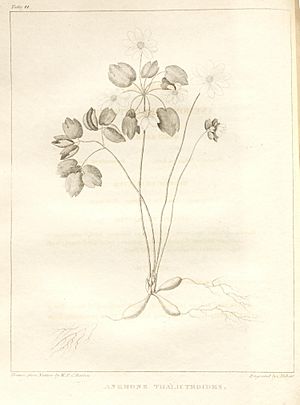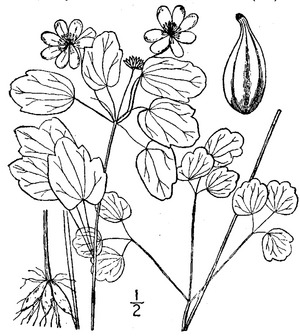Thalictrum thalictroides facts for kids
Quick facts for kids Rue-anemone |
|
|---|---|
 |
|
| Conservation status | |
| Scientific classification | |
| Genus: |
Thalictrum
|
| Species: |
thalictroides
|
| Synonyms | |
|
|
The rue-anemone (scientific name: Thalictrum thalictroides) is a beautiful wild flower. It grows in forests across eastern North America. This plant is a perennial, meaning it lives for many years. It has white or pink flowers. These flowers are surrounded by small leaves. You can see them blooming in the spring.
Contents
What Does the Rue-Anemone Look Like?
The rue-anemone is a smooth plant. It grows from a group of roots that look like small potatoes. Its stems stand up straight. They are usually about 10 to 30 centimeters (4 to 12 inches) tall. A flower grows at the top of each stem.
The leaves at the bottom of the plant have long stalks. These stalks can be 10 to 30 centimeters (4 to 12 inches) long. The leaf blades are divided into three parts, and then each of those parts is divided into three again. The small leaflets are round. Their ends often have three small bumps or lobes.
Rue-Anemone Flowers
The rue-anemone blooms in the spring. Its flowers grow alone or in small groups of 3 to 6 flowers. These groups look a bit like an umbrella. The flowers have short stems. These stems hold the open flowers above the leaves.
The flowers are showy and round. They have 5 to 10 white or pinkish-purple parts that look like petals. These are actually called sepals. Inside, there are 4 to 15 small, green structures called carpels. Many yellow stamens surround the carpels. Stamens are the parts that make pollen. The sepals are about 5 to 18 millimeters (about 1/4 to 3/4 inch) long. The thin parts of the stamens are about 3 to 4 millimeters (about 1/8 to 3/16 inch) long.
Rue-Anemone Fruits
In late spring, the plant releases its fruits. These fruits are called achenes. They are small, about 3 to 4.5 millimeters (about 1/8 inch) long. They are shaped like an egg or a spindle. When they are young, they are green. They have 8 to 10 clear lines on them. When they are ready, they turn dark brown.
How Did the Rue-Anemone Get Its Name?
A famous scientist named Carl Linnaeus first described this plant in 1753. He called it Anemone thalictroides. Later, in 1839, another scientist named Édouard Spach thought it was special enough to have its own group. He created a new group called Anemonella just for this plant.
Spach thought the plant's small size, umbrella-like flower groups, and potato-like roots made it different. However, in 1957, Bernard Boivin moved it back into the Thalictrum group. Today, most scientists agree that it belongs in the Thalictrum group.
Plants That Look Like Rue-Anemone
The false rue-anemone (Enemion biternatum) looks a lot like the rue-anemone. However, the false rue-anemone always has single white flowers. These flowers usually have 5 sepals. They grow individually from the spots where leaves meet the stem. Its stem also branches out more.




